Conclusion
Performance
Let’s take a look at the averages of all our FPS measurements across all the games:
For 1 GPU performance the Titan X beats the Fury X by about 20%. However performance is still quite low and close to unplayable and you’ll really be wanting 2 cards to get acceptable performance on most games. Bear in mind that the Titan X’s had an overclock on them too.
For 2 GPU performance AMD actually ties Nvidia when we focus on the average performance – this is because AMD’s crossfire implementation scales significantly better than Nvidia’s SLI.
This trend continues for 3 way setups. AMD now overtakes Nvidia for a slightly lead in 3 way setups! Let’s examine that scaling:
AMD’s Fury X in 2 way Crossfire on average gets about an 80% gain. This is pretty acceptable. However Nvidia’s SLI is only giving about 50% of the 2nd card’s potential. This is a significant waste of resources and Nvidia should really target improving that!
For 3 way scaling both companies have inefficient performance with AMD taking a slight lead.
However average FPS isn’t everything. The quality of the experience can often be more about stutter. The ideal way to measure this is to actually capture the video output and measure the times between frames and do a statistical analysis on them. However we don’t have a 5K video capture card so we’ll purely be examining the minimum FPS averaged across all games played:
As can be seen Nvidia does a much better job here at providing a smoother experience. If you want to keep your minimum FPS above 40 FPS then you really have to roll with Nvidia. However you have to bear in mind that some of these tests were stuttery on AMD because we sometimes ran with AA high and used so much VRAM that AMD could no longer handle it. If we plot VRAM from both manufacturers then we can see that both systems generally use similar amounts of VRAM up until AMD runs out of memory:
Interestingly though the more AMD GPUs that were used the lower VRAM usage of each Fury. In other words, by adding more Fury cards the end user might be able to run higher settings before running out of VRAM. Nvidia on the other hand is the opposite. More Titans used more memory.
As all 5K monitors are 27″ the PPI is so high that AA is somewhat unnecessary. Only the sharpest eyes will be able to see the difference. Now having said that it should be noted that we had planned to run more of the games (Sleeping Dogs, Hitman Absolution) with higher AA settings, but some games would crash when they were VRAM limited and so settings had to be turned down.
Quality of Experience
Overall the experience was simply better with Nvidia. AMD not only suffered from VRAM issues but also suffered from stuttering on games like The Witcher 3 where VRAM wasn’t even an issue. In addition AMD wouldn’t let you switch resolution from and to 5K in game while Nvidia did.
Power
While readers of this site are more likely to be water coolers who don’t care about power and temperature it’s worth noting that at stock clocks both systems used similar amounts of power during gaming at about 1000W. Once the Titan X’s were overclocked though the power jumped to 1300W. This is another 100W of power per card and this is going to mean that air coolers are going to struggle to keep 3 Titan X’s cool particularly when they are stacked next together in a case with bad airflow. So in 3 way setups AMD not only outperformed Nvidia on average FPS but they also did so by using 300W less! Therefore AMD is really winning on this metric – this really puts to bed their reputation for poor power efficiency that came about when people compared the 980 to the 290x.
Overclocking
Our Titan X’s were great overclockers and so we pushed them hard – enabled by the aftermarket water blocks. For AMD a small overclock turned out to bench stable but games simply weren’t stable with an overclock at all. This is a huge disappointment and means that AMD could do a lot better if that was figured out. Hopefully we will see bioses released that enable real overclocking. Because of this Nvidia really wins this category.
Design & Features
Titan X’s huge amount of VRAM is one of it’s biggest selling points. 12GB is future proof while the 980 TI’s 6GB is enough for now. The Fury X however with only 4GB ran out of VRAM when we tried maximum settings on 4/9 games. This seems very “last generation” and I do believe that AMD made a mistake by choosing only 4GB. For a long time VRAM was one of AMD’s competitive advatanges – and now it has become a disadvantage.
We love AMD’s integrated closed loop cooler. While it does increase cost slightly it enables the Fury X to take advantage of HBM and to be a small card with excellent performance. A watercooling block isn’t necessary particularly given that the card doesn’t overclock and so water cooling simply becomes about a nicer and cleaner look in the case. A watercooling block may also enable the GPU to become a single slotter.
We’d have to give this category to AMD despite the lack of VRAM and HDMI 2. We love the smaller form factor and the ability to go single slot.
Value
Now all of this talk about performance and features ignores the biggest factor here – price. At $999 the Titan X is significantly more expensive than the Fury X at $649. For the price of 2 Titan X’s you could buy 3 Fury X’s. If we take those average FPS numbers and divide them by the price then we are really looking at the bang per buck that each card brings:
As scaling isn’t perfect we see that the single card setup is always the best value. AMD is of course going to win the value award vs the Titan X, but any reader would of course ask how the 980 TI would do on this metric. The 980 TI has 6GB of memory which in these tests seems to be enough to enable it to never be limited. Therefore performance should be similar (probably about 2816/3072 of the performance assuming a similar overclock) but the value at $649 per card would be significantly better. However as we haven’t tested it, we really can’t include it here and so AMD wins the value award!
Verdict
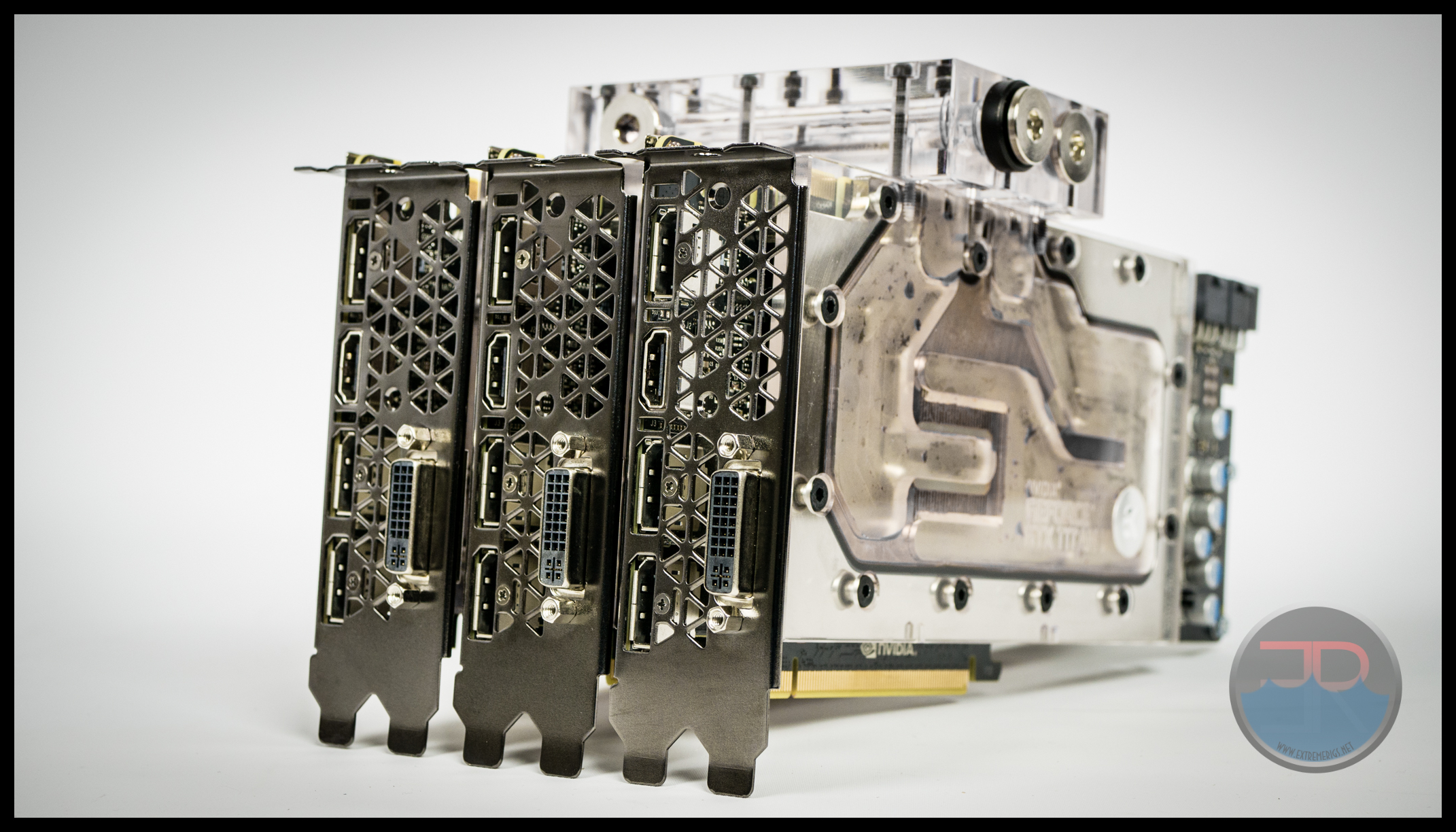
Nvidia Titan X – Gold Award
Nvidia wins the gold award because the performance was amazing and most importantly the quality of the experience is better. While SLI scaling was disappointing, the single card did so well that it didn’t matter so much. SLI scaling is really our only complaint with Nvidia’s technology. At 5K we really feel that 2 cards is the sweet spot. The 3rd card returns little value for money. The real choice the consumer must make is whether to cheap out and get the 980 TI or not. 12GB of VRAM is a lot and 6GB may be enough. Having said that only a few years ago Nvidia thought 2GB was enough for a high end card.
AMD Radeon Fury X – Value Award
The Fury X has some cool technology in HBM. Clearly it’s working and it’s impressive that AMD are still competing with essentially a very similar core technology to the 7970. However we believe that 4GB is simply not enough VRAM for a high end card of this calibre. We believe this is the cause of some of the stuttering and consistently low minimum frame rates. AMD’s crossfire scaling also is far superior to Nvidia’s SLI but is let down by driver issues where stutter can sometimes occur even when VRAM is not limiting. AMD clearly also wins the value competition – and when you factor in the smaller size and ability to go to a single slot when using water blocks then you could fit an enormous amount of GPU power into a far smaller space by taking the AMD route. However the end result left us simply unhappy with the AMD experience at 5K even though the numbers were really quite impressive. After all 3x Fury X’s averaged higher FPS than 3x Titan X’s for 2/3 of the price! If the Fury X’s VRAM had been increased and if the drivers were a bit more polished then AMD could have won this roundup. Instead Nvidia wins the overall award. But let’s not diminish what AMD have achieved here – a powerful, space efficient GPU that scales up very well in crossfire. We’re very excited to see what AMD can do in the future.









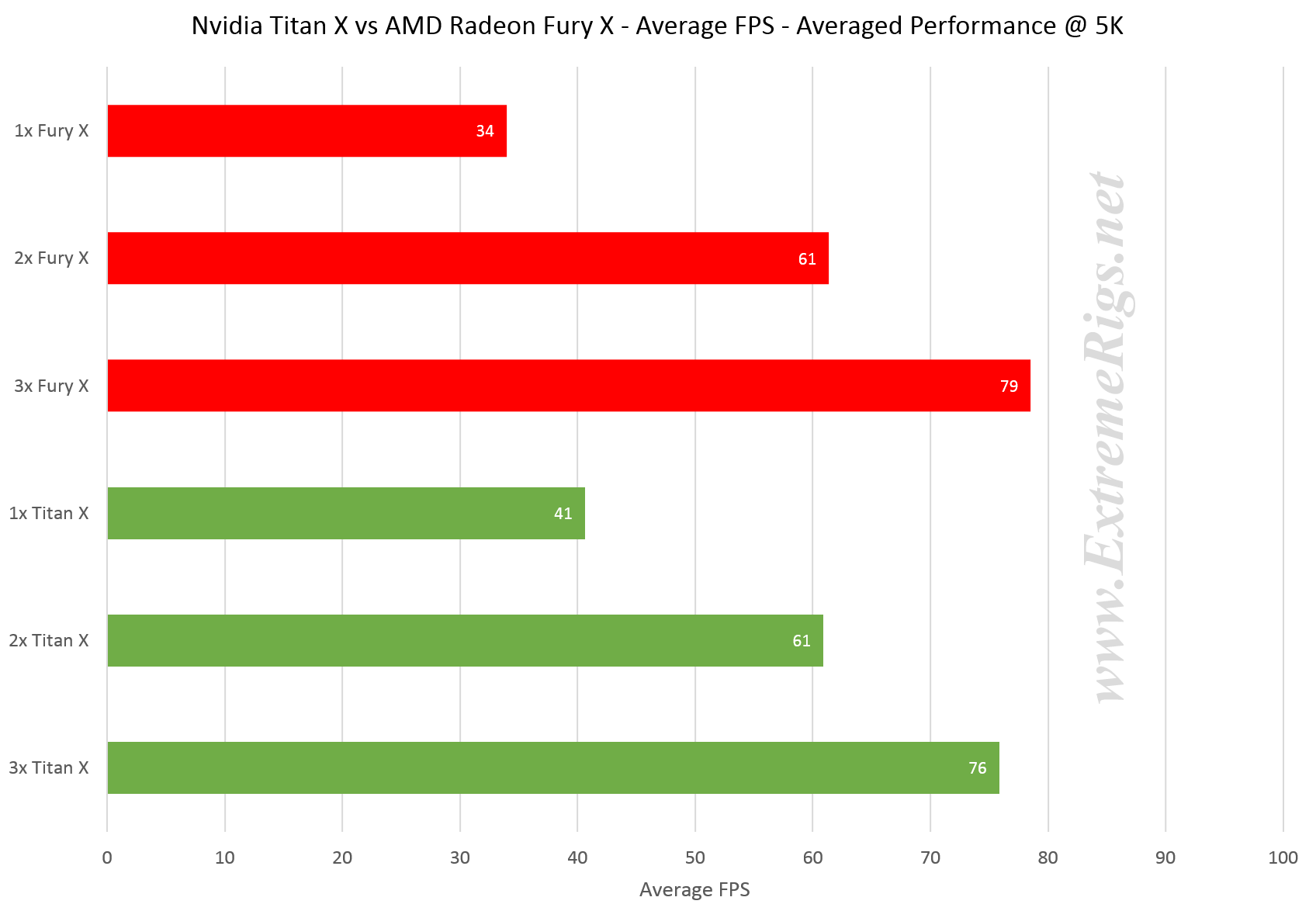
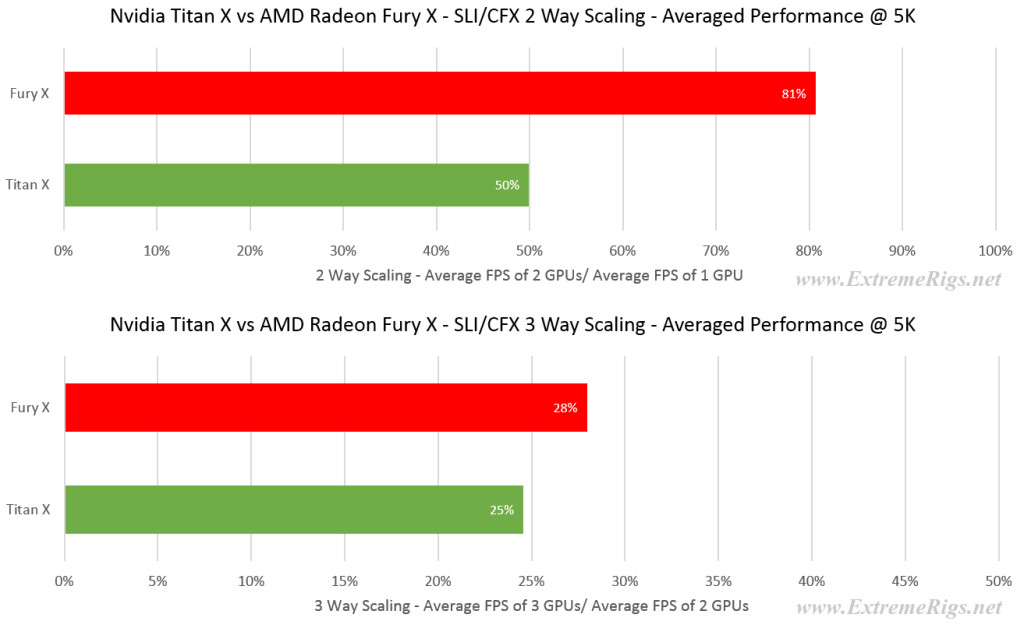
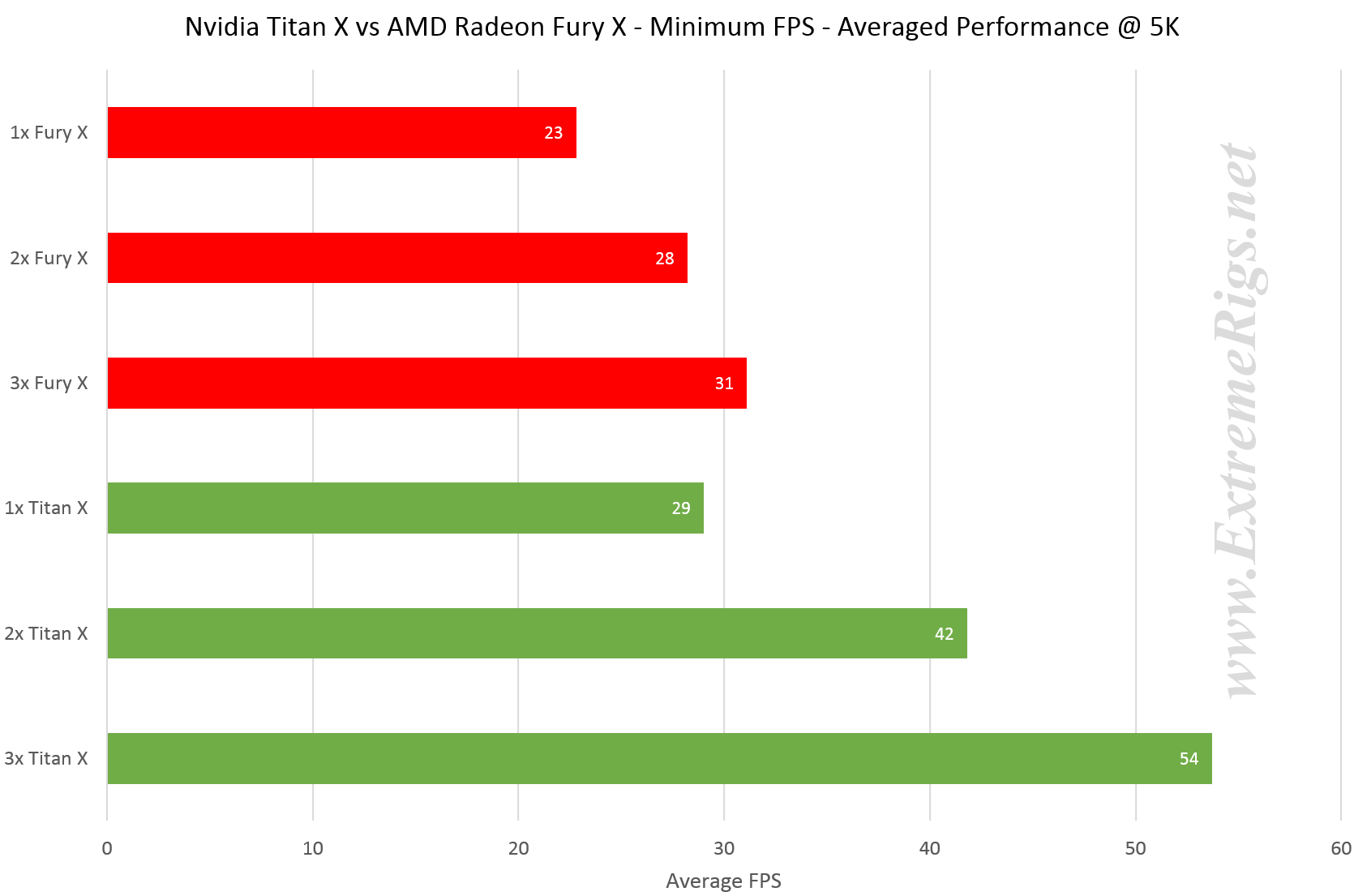
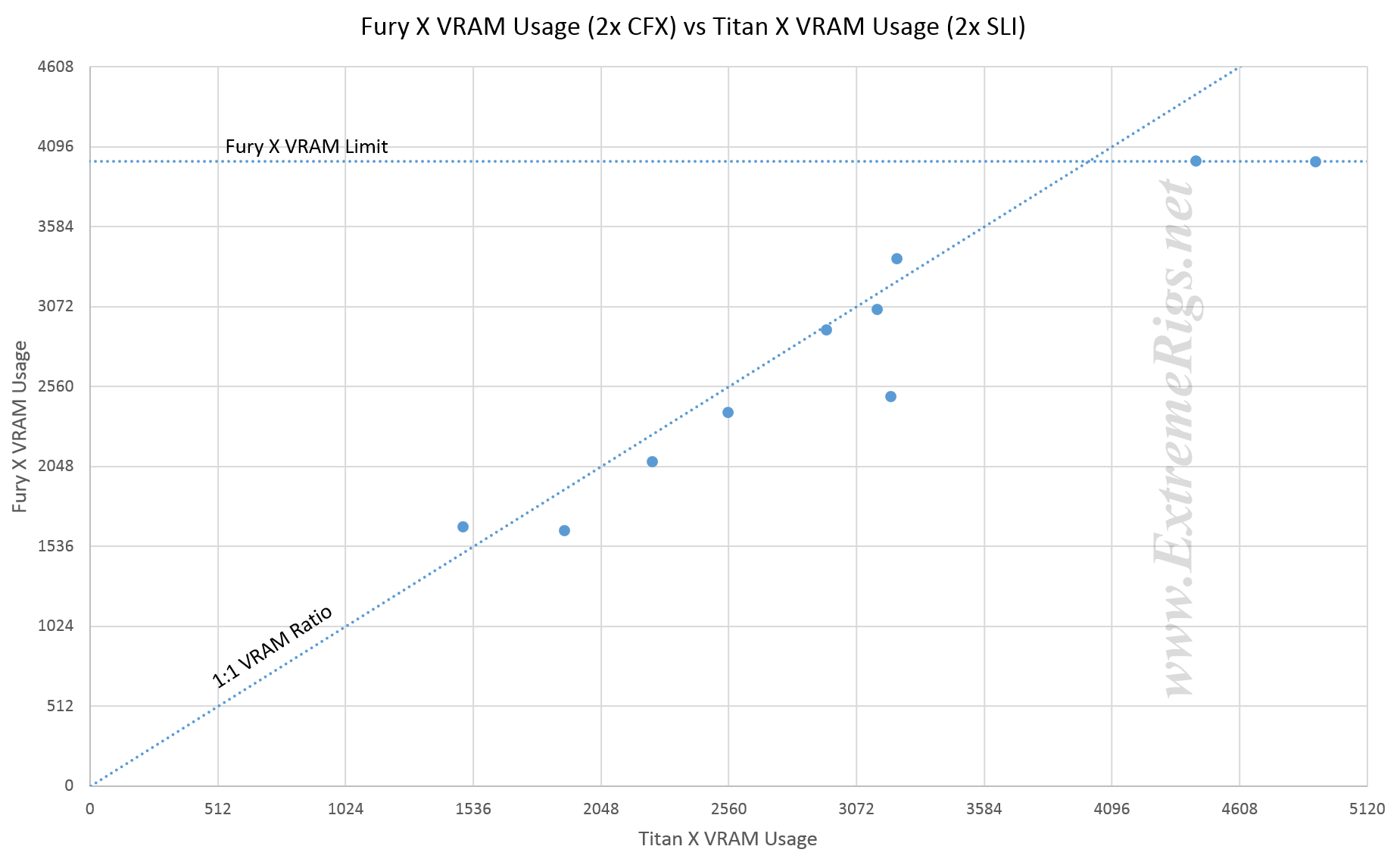
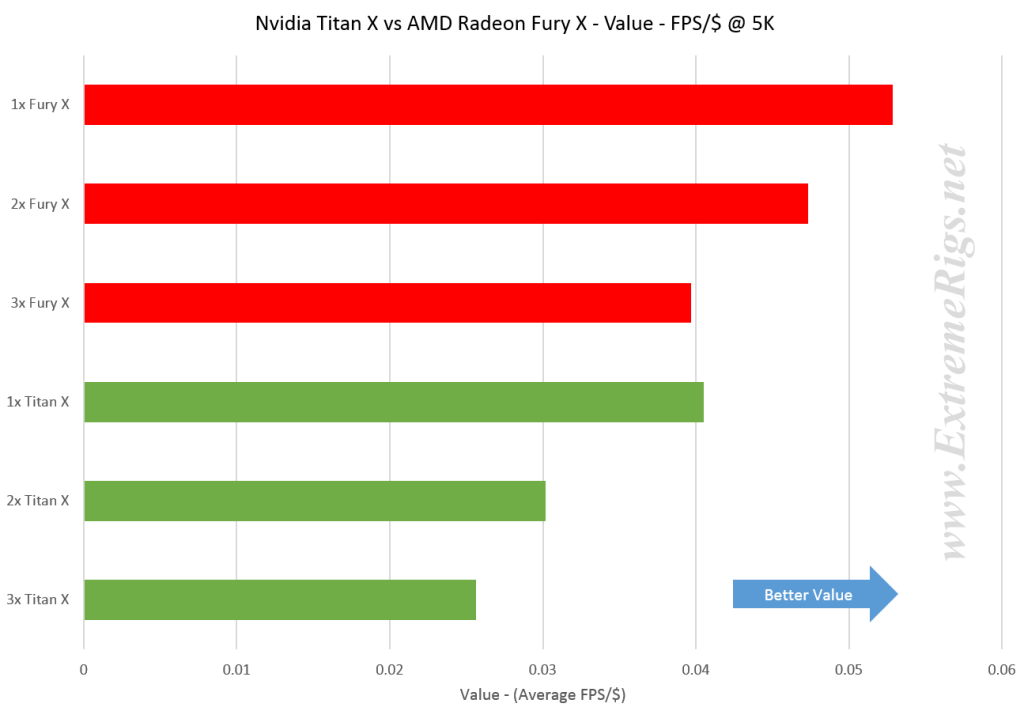






To be honest, I started reading this article with a thought that “well, how good can it be? ERs are watercooling guys so, nah! can’t expect too much”. But after reading the whole of it, I have to say, This is by far the one of the best comparative reviews I’ve ever seen, and really met all my expectations. Hats off to you guys!
Say, FuryX did have the claim in its pre-release rumor to be a TITAN X competitor, but then AMD shrunk that note to 980 Ti. So I think comparison with 980 Ti would’ve been better comparison (and seat clenching brawl) than this, and the clock-to-clock performance metrics but nonetheless, this is wayy too good also!
About capping the vRAM on FuryX in few games there, it also suffers from similar performance degradation on 4K and downwards. And as you may have seen on other reviews, FuryX does worse in sub-4K than the competition and even worse in 1080p. I’ve dug through every review out there yet haven’t found the reason behind this. What could be the reason?
And that scaling on nVidia – you know nvidia does claim that their SLI bridge isn’t a bottleneck, and so it is proved here :P. When AMD did introduce XDMA, I had this belief – AMD took the right path, bridges will suffer from less bandwith sooner or later, and PCIe already has the room for accommodating the data of the bridges. So XDMA did (well, now it is “do” :D) makes sense!
But it’s sad to see AMD not delivering smoother experience overall. If they could handle that thing, this should certainly deserved the choice over any of those higher average FPS of Titan X. But I think AMD is working on Win10 & DX12 optimized drivers and trying to mend it with bandages for now.
My only complain was the choice of TitanX over 980 Ti and clock-to-clock performance, but other than this, this is a very great review! Hats off to you again!
Agreed with Frozen Fractal. I was more than pleasantly surprised with the quality of this review, and I hope you continue to do these more in the future. A 980 Ti would have been nice to see too given the price.
Keep up the great work!
Thanks! I agree the 980 TI would have been a better comparison – then prices would have lined up. “Sadly” we only had Titan X’s and we weren’t willing to go out and buy another 3 GPUs to make that happen. However if anyone wants to send us some we’d gladly run em haha. I was simultaneously impressed with AMD’s results while saddened that after all the work on frame pacing that things still aren’t 100% yet. Hopefully
Question…you overclocked the Titan X to 1495MHz which is “ok” for a water cooling build. I won’t complain…though I’m surprised at why that’s all you were able to achieve as I can pull that off on Air right now (blocks won’t arrive until next week). Main question though…why wasn’t the memory overclocked? A watercooled Titan X has room to OC the memory by 20%, bumping up the bandwidth to 400Gbps, which brings it quite a bit closer to the 512Gbps of the HBM1 in the Fury X.
Although we didn’t mention it the memory was running a mild OC at 7.4Gbps up from the stock 7gbps
6gbps – so yes about the same as your 20%
This is what concerns me about your understanding of overclocking. The Titan X memory is 7GHz at stock. At 7.4GHz you’re only running a 5.7% OC on the memory…
Hah you’re right, I was looking at titan stock memory settings not titan x. Yes it could have been pushed harder. Still though single Titan X was really good compared to Fury X – the issue it had was scaling. So unless scaling is significantly effected by memory bandwidth then I don’t think it changes the overall results much. When we re-run with overclocked furies we’ll spend a bit more time on the Titan X overclock too.
Don’t get me wrong…SLI scaling is definitely an issue and will still exist regardless. But you’d be surprised how important memory clocks can be depending on the test you’re running. I found this out when I was running the original GTX Titan Tri-Sli in the overclock.net unigine valley bench competition and came in second place. Leave the official redo for your next review of Fury X OC vs Titan X OC, as you mentioned. But to satisfy your own curiousity, try a higher memory clock and see what happens. If you were looking to squeeze out every last ounce out of your Titan X, you should check out http://overclocking.guide/nvidia-gtx-titan-x-volt-mod-pencil-vmod/ as well.
My Phobya nanogrease should be coming in tomorrow so I’ll finally be putting my blocks on as well. I’m going to compare my performance results with yours next time you run your benches. So make sure you do a good job.
Excellent review. I am also running an Asus Rampage Extreme V with a 5960x OC’d to 4.4Ghz so your data really was telling. I’m running a single EVGA GTX980TI SC under water. I previously ran 2 Sapphire Tri-X OC R9 290s under water but opted to go with the single card.
Did you use a modded TitanX bios? What OCing tool did you use to OC the TitanX. I would like to try to replicate the parameters and run the single 980TI to see how close I am to your single TitanX data. Thank you.
Eh, i don’t really see the point of running AA in 5K Too bad it’s 5K btw, 4K is more reasonable. Too bad Fury X has problems with the Nvidia titles(W3 for example).
Too bad it’s 5K btw, 4K is more reasonable. Too bad Fury X has problems with the Nvidia titles(W3 for example).
But man, the scaling and texture compression on amd cards are absolutely amazing. If only they weren’t bottlenecked by the HBM1’s 4GB of VRAM.
[…] Review: Titan X vs Fury X in a Triple CFX SLI Showdown […]
[…] Review: Titan X vs Fury X in a Triple CFX SLI Showdown […]
[…] Review: Titan X vs Fury X in a Triple CFX SLI Showdown […]
Comments are closed.